Table of Contents
What if the secret to perfect smoked salmon isn’t in the smoker—but in the brine? Most people focus on wood chips or temperature, but the real magic happens long before the fish hits the grill. A well-crafted brine locks in moisture, balances flavors, and ensures every bite melts in your mouth.
The right mix of kosher salt and brown sugar creates a foundation that enhances the natural richness of the fish. Timing matters, too: curing for the right number of hours—based on thickness—prevovers the protein from becoming too salty or dry. After rinsing, a quick drying phase under a fan or in the fridge forms a sticky surface layer called a pellicle. This step is crucial for smoke to cling evenly during cooking.
Whether you’re new to smoking fish or a seasoned enthusiast, this guide simplifies the process. You’ll learn how to balance ingredients, adjust curing times, and achieve that signature silky texture. Ready to transform your results? Let’s dive in.
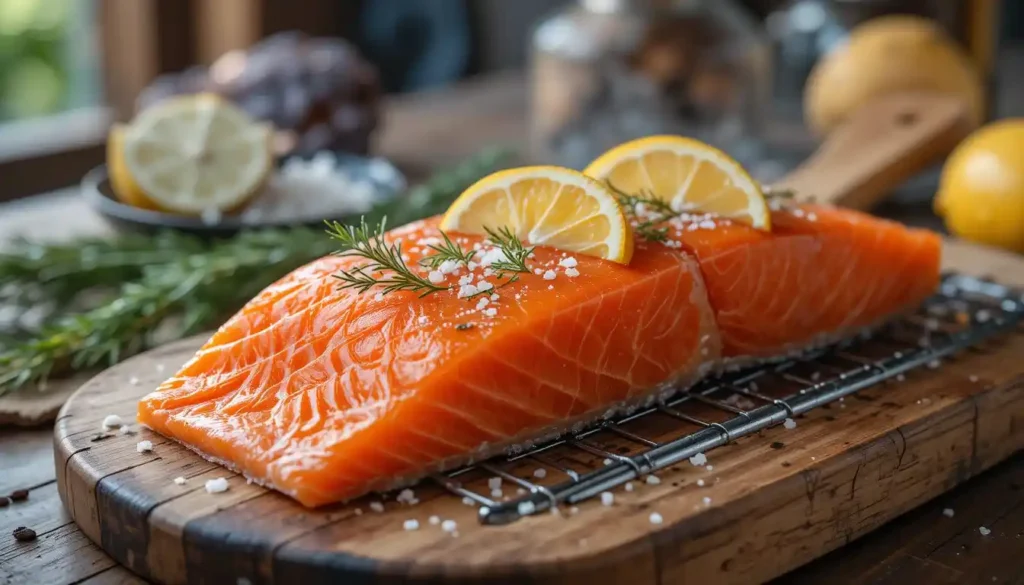
Understanding the Brining and Curing Process
The foundation of mouthwatering smoked fish lies in two critical steps: brining and curing. These methods transform raw fillets into tender, flavorful results by balancing chemistry and timing. Let’s break down how they work and why precision matters.
What Is Brining and Why It Matters
Brining involves soaking your catch in a solution of kosher salt, brown sugar, and water. Salt pulls moisture out while sugar adds subtle sweetness, creating a protective barrier against spoilage. “The right ratio ensures flavor penetration without overpowering the fish,” notes seafood chef Emily Torres. Thinner cuts need just 4 hours in the brine, while thicker portions require up to 48 hours for even curing.
Developing a Perfect Pellicle for Smoke Adherence
After rinsing off the brine, air-drying forms a glossy layer called a pellicle. This sticky surface acts like glue for smoke particles. Place fillets under a fan or in the fridge for 1–2 hours to achieve this texture. Skipping this step? You’ll get uneven flavor and wasted effort.
Temperature control is key. Gradual heat buildup in your smoker prevents albumin (those white proteins) from seeping out. Aim for 150–160°F initially, then increase slowly. This keeps the fish moist and avoids a rubbery finish. Ready to mix your brine? The next section covers exact measurements and custom tweaks.
Smoked Salmon Brine Recipe: Essential Ingredients and Measurements
Precision transforms good results into exceptional ones. Every element in your mixture plays a distinct role, from enhancing flavor to ensuring texture. Let’s explore the core components and how to adapt them for various needs.
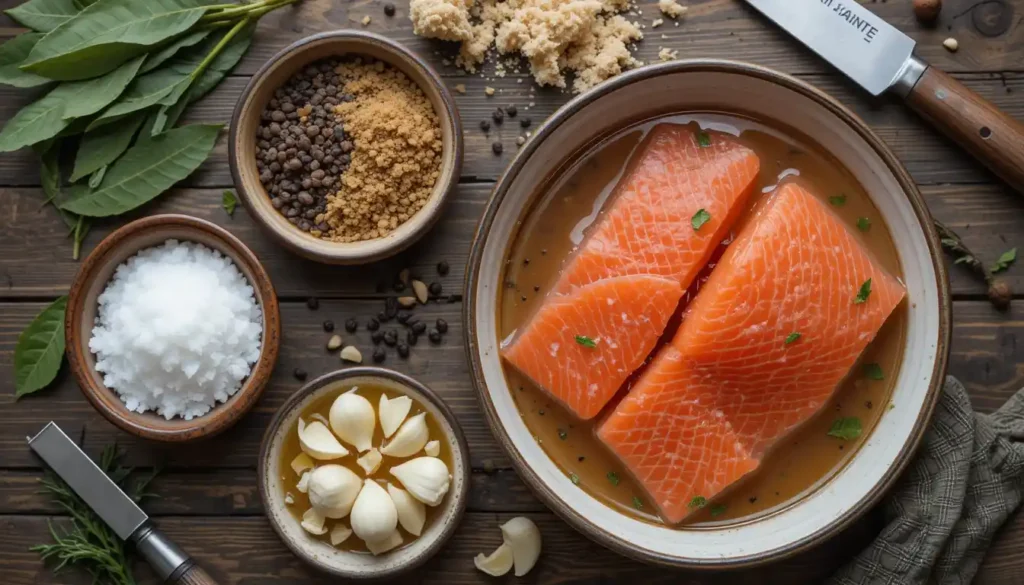
Key Ingredients Overview: Kosher Salt, Brown Sugar, and Water
Three staples form the backbone of your mixture. Kosher salt draws moisture while seasoning evenly. Brown sugar counters saltiness with caramel-like sweetness. Water dissolves these elements, creating a balanced solution.
| Ingredient | Measurement | Purpose |
|---|---|---|
| Kosher Salt | ⅓ cup | Preserves and seasons |
| Brown Sugar | ½ cup | Balances salinity |
| Water | 4 cups | Dissolves ingredients |
Use a non-reactive container like glass or stainless steel. Fully submerge your fillets to guarantee uniform curing. Thicker cuts need longer soaking times—up to 48 hours for portions over 1.5 inches.
Customizing Your Brine for Different Salmon Types
Varieties like sockeye or king require tweaks. Leaner fish benefit from added soy sauce for depth. Oil-rich options pair well with citrus zest or herbs like dill.
Adjust ratios based on fat content:
- Pink: Reduce salt by 1 tbsp
- King: Increase sugar by 2 tbsp
Optional additions like dry white wine or cracked pepper let you personalize flavors. Always measure carefully—too much salt overwhelms, while excess sugar delays curing.
Step-by-Step Guide to Brine and Smoke Your Salmon
Mastering the process requires attention to timing and technique. Follow these steps to ensure your efforts yield tender, flavorful results every time.
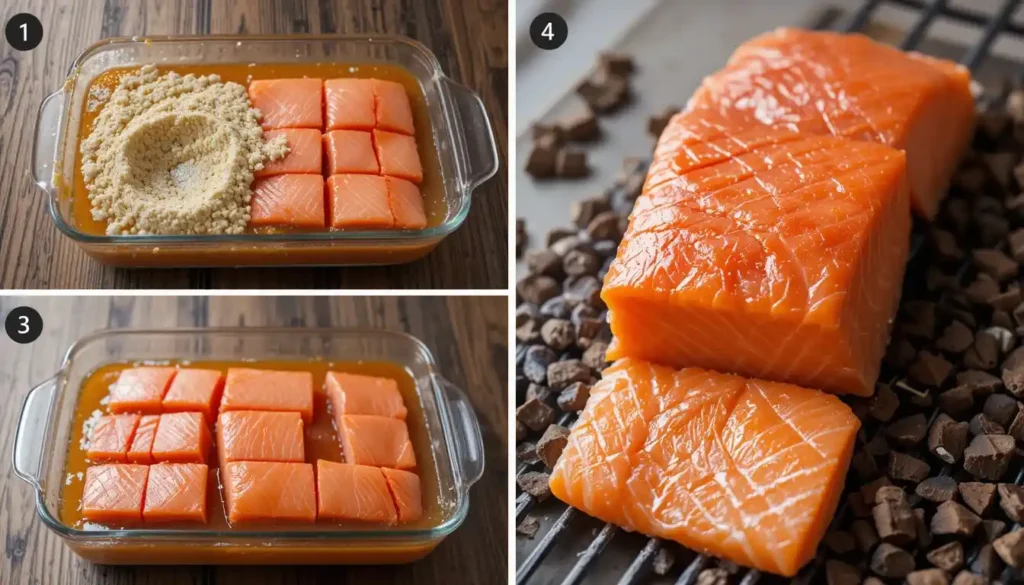
Preparation Tips and Brine Duration Guidelines
Remove your fillets from the solution and rinse thoroughly under cold water. Pat them dry with paper towels, then place them on a wire rack. Set up a fan or position the rack in your refrigerator for 1–2 hours. This creates the essential sticky layer that traps smoke.
Smoking Techniques and Temperature Control
Preheat your equipment to 140°F–150°F. Add water or ice to the drip pan to stabilize heat. Place the fillets skin-side down, leaving space between each piece. Smoke for 2 hours at this low temperature, then gradually increase to 175°F over the next 60–90 minutes. Target an internal temperature of 145°F for doneness.
Finishing Touches: Basting and Resting Your Salmon
Brush the surface with maple syrup or honey every 30 minutes after the first hour. This adds shine and masks any white protein streaks. Once done, let the fillets rest on a rack for 15 minutes before refrigerating. If albumin appears, reduce heat next time—your dish is still edible!
Conclusion
Your journey from raw fillet to flavorful masterpiece hinges on mastering a few core principles. Balancing kosher salt and brown sugar creates the foundation for tender, evenly seasoned results. Proper curing times—whether 4 or 48 hours—ensure moisture retention without overwhelming the fish’s natural richness.
Don’t skip forming the glossy pellicle layer. Air-drying under a fan or in the fridge helps smoke cling to every inch. Temperature control during cooking prevents rubbery textures: start low (150°F), then increase heat gradually. Basting with honey or maple syrup adds shine while masking any protein streaks.
Store your finished product in the refrigerator for up to 10 days, or freeze it for longer freshness. Experiment with citrus zest, cracked pepper, or soy sauce to personalize flavors. Ready to impress? Fire up your smoker, trust the process, and share your success with fellow enthusiasts.
With these techniques, you’ll transform ordinary fillets into gourmet-quality creations. Every step—from measuring ingredients to resting the final product—builds confidence in your culinary skills. Now go make magic happen.
FAQ
Why is brining important for preparing fish?
Brining enhances flavor, retains moisture, and helps preserve the protein. It balances the natural oils and creates a foundation for smoke absorption during cooking.
Can I substitute regular salt for kosher salt in the mixture?
Yes, but adjust measurements carefully. Table salt is denser, so use 25% less to avoid over-salting. Always dissolve it fully in water first.
How long should I let the fish sit in the solution?
For fillets under 1.5 inches thick, 8–12 hours works best. Thicker cuts or whole sides may need up to 24 hours. Refrigerate during this process.
What’s the purpose of forming a pellicle before cooking?
A tacky surface layer helps smoke particles adhere better. Air-dry uncovered in the fridge for 2–4 hours after rinsing off the cure.
Does the fat content affect preparation choices?
Higher-fat varieties like king or sockeye handle longer smoking times well. Leaner types (e.g., coho) benefit from shorter sessions to prevent dryness.
How do I store leftovers after cooking?
Keep cooled portions in an airtight container for up to 5 days. For longer storage, vacuum-seal and freeze for 2–3 months. Thaw in the fridge overnight.
Can I use a gas grill instead of a dedicated smoker?
Absolutely. Use indirect heat with soaked wood chips in a foil pouch. Maintain temperatures between 175°F–200°F for optimal results.
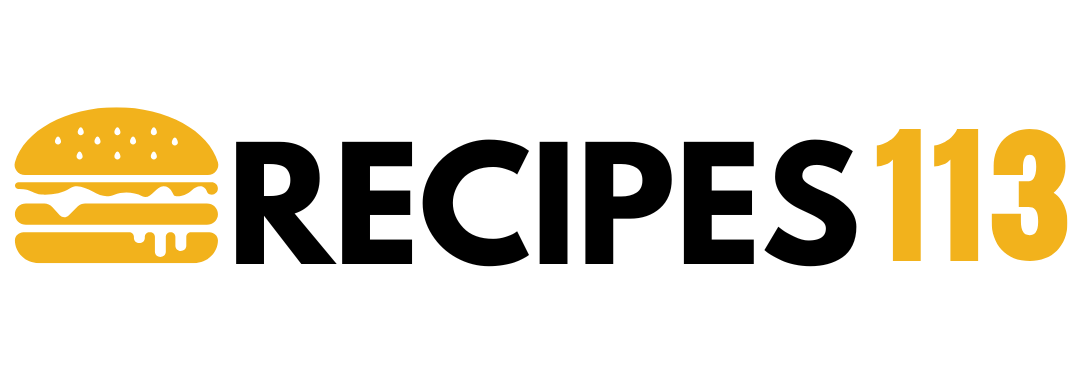
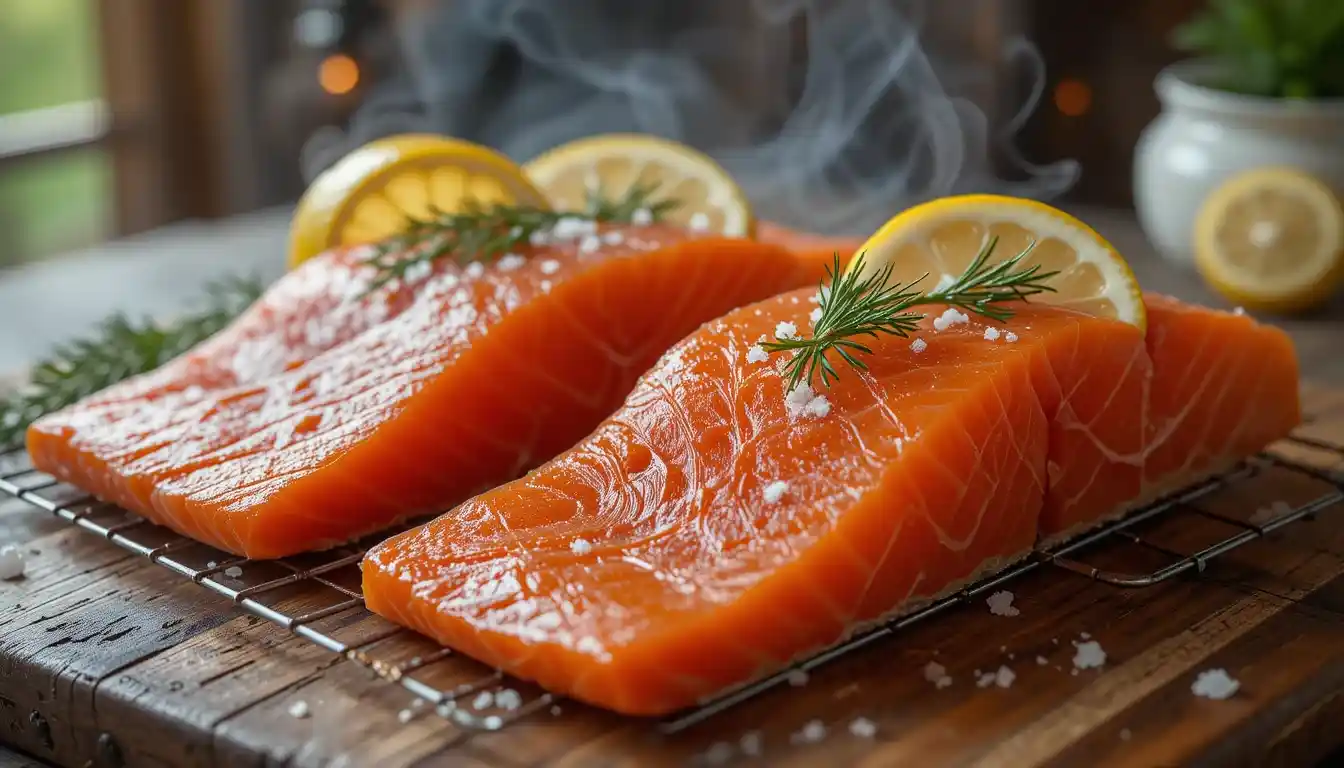
2 thoughts on “Delicious Smoked Salmon Brine Recipe”
Comments are closed.